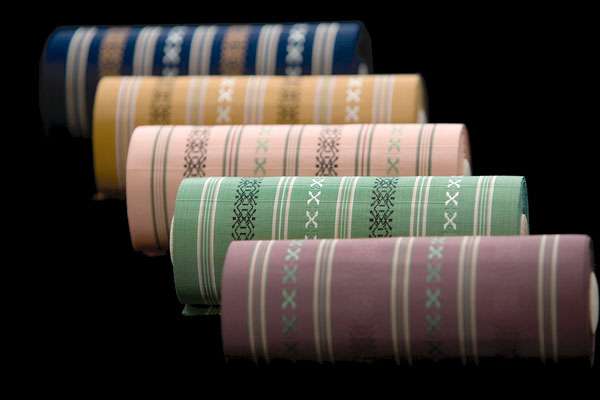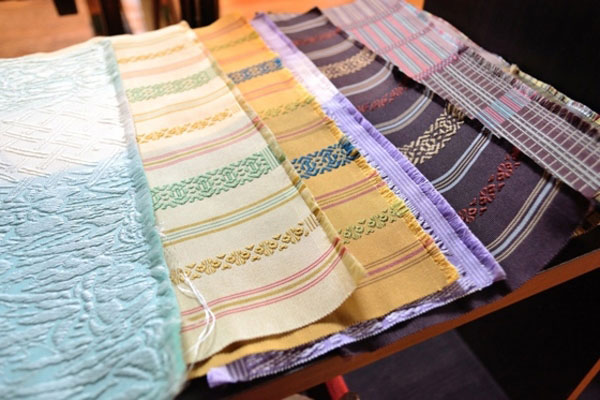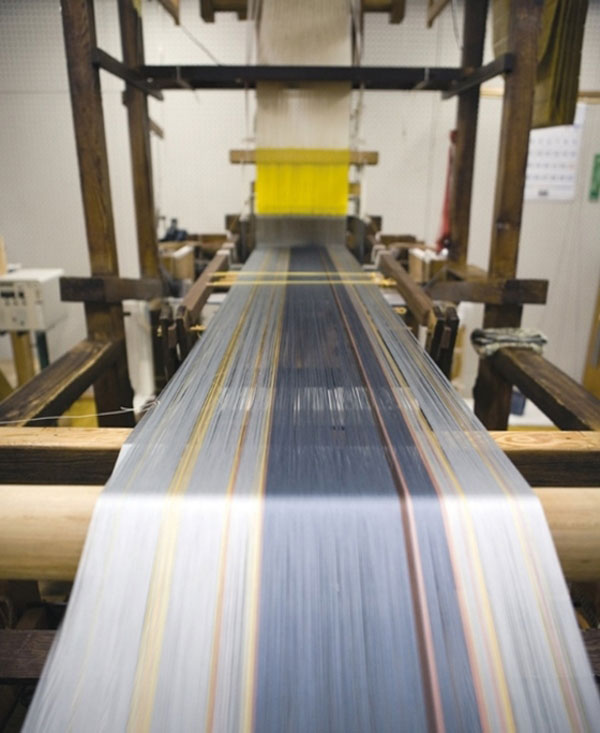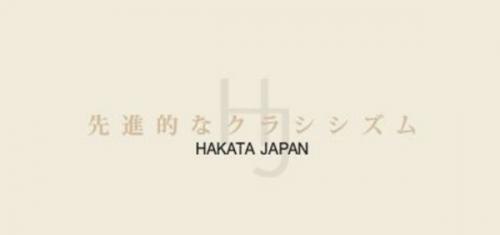 Photo:Fukuoka City
Photo:Fukuoka City
- Woven textiles
- Fukuoka
Hakata brocade Hakata ori
770 years of traditions and techniques
make the unique comfort of this tight textile
Description
What is Hakata brocade ?
Hakata ori refers to the ori or woven cloth produced in and around Hakata, Fukuoka prefecture. Hakata weaving techniques, which originated in China, have shaped this unique cloth. It has been highly regarded for its high quality throughout the ages.
It is characterized by a tightly woven texture that is attained by using a number of thin warps (perpendicular threads) that are strongly drawn by thick wefts which raise the warps to the surface into a pattern. With excellent tightness, thickness, and durability, Hakata brocade was sought after as Japanese kimono sashes for men called obi, sashes for samurai in ancient times, and loincloths for sumo wrestlers in recent years. A silk rustling sound known as kinunari in Japanese is produced when a kimono sash is tightened, which is unique to Hakata ori.
Raw silk, silk threads, metallic fiber, and Japanese silk twine are used to produce an elaborately woven fabric, along with gold foils, silver foils, and lacquered leaf. Hakata ori boasts different types of patterned fabrics with varying weaving techniques: Kenjo/Kawari kenjo, Hira hakata, Kando, So-uke, Mojiri ori, Kasane ori, and Enuki hakata. These traditional, well-honed techniques have been passed down for generations.
History

In 1241, during the Kamakura period (1185-1333), a Hakata merchant named Yazaemon MITSUDA returned from China during the Song Dynasty (960–1279) with the Kara ori or Chinese weaving techniques. In the 16th century, constant improvements by his descendant Hikosaburo MITSUDA brought the techniques to the next level. Mitsuda learned the new weaving techniques of the Ming Dynasty (1368–1644) in China and combined them with his inherited techniques. The result was a thick woven fabric with a raised stripe design and willow branch pattern depicting a tokko (single-prong) and flower tray used in Buddhist rituals.
In 1600, when Hakata was under the reign of the Kuroda clan, a five color pattern that represents the universe was developed and presented to the Imperial Court as a tribute. After having their growth limited during the Edo period (1603-1868) by weaver stock regulations, artisans in Hakata were liberalized by Meiji era (1868-1912) economic reforms. This resulted in the establishment of Hakata Ori Corporation, forerunner of Hakata Ori Industrial Association which preserves the quality of the craft. Also Hakata ori began to produce sashes for women during the late Meiji period.
Production Process
 Photo:Fukuoka City
Photo:Fukuoka City
- 1. Design
The first step of Hakata ori is deciding the design. The designed pattern is planned accordingly by distinct weave textures and colors. When the design is traced on graph paper, each grain is colored according to the design. The design process requires paying close attention to minor details, but it has become more efficient with computerization.
- 2. Dyeing
The colors were already selected during the design process, so the silk threads are dyed during this step. The dyeing process involves washing raw silk with soapy water to bring out its luster. Then the warps (parallel silk threads) and wefts (perpendicular silk threads) are separated and dyed one by one in an iron pot filled with boiling water mixed with dyeing solution. The threads are dyed with either a chemical or plant based dye. Dyed threads are weather-sensitive and can have the colors easily altered, therefore, experienced craftsmanship and proper judgment is required. After dyeing, the threads are untwisted and untangled in order to be uniform.
- 3. Preparation for weaving
For Hakata ori, the design is created by spooling the warp threads. Following the spooling of the aligned warps around the tube, a process called hajitake is carried out. It consists of setting the warps in the loom according to the pattern design. It is a process of threading the warps through the hooks in the Jacquard loom* which moves the warps up and down. With the end of the warps tied to the heddle (a looped cord that separates and divides the warp threads), the refined silk threads are aligned, stretched on the loom, and threaded through a reed which guides the motion across the loom. This process absolutely needs to conform with the design. Also, because this is an arduous step with a lot of delicate silk threads, the artisan needs to have a great deal of patience.
*A Jacquard loom uses a chain of punch cards to instruct it on how to automatically make complex designs.
- 4. Weaving
The Hakata ori production process uses the modern technology of machine weaving, however there is also a traditional handweaving technique called uchikaeshi mitsuuchi which is upheld. The technique is strongly pushing weft threads into the warp threads with the reed guiding the weft threaded shuttle. When done properly, the texture gains enhanced appeal because of the tightly wound and detailed design that results from this step. The loom requires careful adjustments depending on the climate. Rich experience and expertise of the artisan delivers the highest quality fabric.
The Hakata ori weaving process doesn't involve piece dyeing, allowing a woven cloth to be immediately inspected and brought to market.
Representative Manufacturers
HAKATA JAPAN

"Advanced classicism" is the concept of our brand. We protect the traditional sense of beauty of Hakata textiles while creating progressive and stylish designs with high skills and excellent techniques. We always strive to provide our customers with modern and original Hakata textiles.
-
Founded1928
-
ClosedOpen all year long
-
DirectorNobuo OSHIUMI
-
Business Hours10:00am to 7:00pm
-
Address
-
Website
-
Tel.+81-92-263-1112
Facility Information
Takumi Art & Craft Gallery

-
Address
-
Tel.+81-92-406-6762
-
Closed2nd and 4th Monday of the month
-
Business Hours10am to 7pm
-
Website
Related Artists
- You will be redirected to the artist's page on the Gallery Japan website
Other Woven textiles
- Nishijin brocade
- Yuki tsumugi silk
- Kurume traditional resist-dyed textiles
- Ojiya chijimi textiles
- Hakata brocade
- Ushikubi tsumugi silk
- Chichibu-meisen silk
- Miyako ramie textile
- Shiozawa tsumugi silk
- Kumejima tsumugi silk
- Omi ramie cloth
- Ryukyu traditional resist-dyed textiles
- Kiryu brocade
- Murayama-oshima tsumugi silk
- Yumihama traditional resist-dyed textiles
- Chibana-hanaori textiles
- Hon-shiozawa silk
- Oitama tsumugi silk
- Ojiya tsumugi silk
- Yaeyama cotton cloth
- Yaeyama ramie cloth
- Honba oshima tsumugi silk
- Shinshu tsumugi silk
- Shuri brocade
- Tama brocade
- Yomitanzan-hanaori textiles
- Isesaki traditional resist-dyed textiles
- Hachio island silk
- Nibutani bark cloth
- Uetsu tilia bark cloth
- Awa-shijira cotton cloth
- Kijoka banana fiber cloth
- Tokamachi traditional resist-dyed textiles
- Tokamachi akashi chijimi textiles
- Yonaguni brocade
- Yuntanza minsa
- Flower pattern textiles
- Oku-Aizu Showa Karamushi Textiles































































































































































































































































































